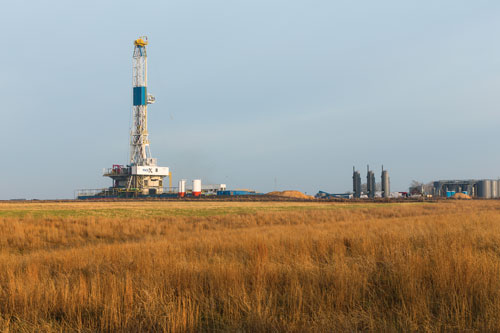U.S. Shale Oil Sector Sees Revival Through Advanced Technology Adoption, Financial Obstacles Remain
(Reuters) — Technology advances are making it possible for U.S. shale oil and gas companies to reverse years of productivity declines, but the related requirement to frontload costs by drilling many more wells is deterring some companies from doing so.
While overall output is at record levels, the amount of oil recovered per foot drilled in the Permian Basin of Texas, the main U.S. shale formation, fell 15% from 2020 to 2023, putting it on par with a decade ago, according to energy researcher Enverus.
That is because fracking, the extraction method that emerged in the mid-2000s, has become less efficient there. In the technique, water, sand and chemicals are injected at high pressure underground to release the trapped resources.
Two decades of drilling wells relatively close together, resulting in hundreds of thousands of wells, have interfered with underground pressure and made getting oil out of the ground more difficult.
"Wells are getting worse and that is going to continue," said Dane Gregoris, managing director at Enverus Intelligence Research firm.
But new oilfield innovations, which began being implemented more widely last year, have made it possible for fracking to be faster, less expensive and higher yielding.
The advances in the past few years include the ability to double the length of lateral wells to three miles and equipment that can simultaneously frack two or three wells. Electric pumps can replace high-cost, high maintenance diesel equipment.
"Companies now can complete (frack) wells faster and cheaper," said Betty Jiang, an oil analyst with Barclays.
A drawback to the new simultaneous fracking technology, also called simul-frac, is that companies need to have lots of wells drilled and ready to move to the fracking phase in unison before they can proceed. Pumps inject fluids into and get oil and gas out of two or three wells at the same time, instead of just one.
Because these act as an interconnected system, wells cannot be added piecemeal. But companies eager to cut costs have not deployed enough drill rigs to capitalize fully on the potential of the innovations.
"Instead of drilling the wells and getting production in a few months, you have got to drill eight wells, or 10 wells," said Mike Oestmann, CEO of Tall City Exploration.
"That's $100 million in the ground before you see any revenue," he said. "For small companies like Tall City, that's a big challenge."
The number of active drilling rigs in the U.S. this month fell nearly 18% from a year ago.
Simul-fracking can also lower well costs by between $200,000-$400,000, or 5%-10% apiece, said Thomas Jacob, senior vice president of supply chain at researcher Rystad Energy estimates.
New Tech Supports Record Production
Oil analysts anticipate use of the new technology will accelerate. "We saw a trend of companies shifting to simul-fracs in the second half last year, and that is only going to continue," said Saeed Ali Muneeb at energy analysis firm Kayrros.
Longer wells and advancements in fracking techniques are more than offsetting declining productivity and limited rig count, helping the U.S. reach record oil production volumes.
The top U.S. shale-producing regions are forecast next month to hit the highest output in five months with new-well production up 28% from a year ago, according to the U.S. Energy Information Administration.
"Companies are making a fine-tuning and getting better and better in fracking," said Oestmann. "Without them, production would fall."
Innovations are going to gain scale once top producers like Exxon Mobil Corp. and Chevron Corp. adopt them more broadly, shale experts said.
Mid-sized shale firms like Pioneer Natural Resources that can afford the costs were first to embrace the new methods. The positive results make them more attractive to big firms like Exxon, which is awaiting regulatory approval to buy Pioneer.
But the biggest shale producers have committed to using oil revenue to finance shareholder returns rather than drilling expansion. Two of the biggest shale oil operators, Exxon and Chevron, have missed targets for Permian production in the past years.
Exxon said its own new fracking technology will allow it to extract an extra 700,000 barrels of oil equivalent per day (boepd) from Pioneer's assets by 2027, tripling output there to 2 million boepd.
Chevron is increasing use of simul-fracs and says the technique will help it increase Permian production by 10% this year to 900,000 boepd. It also completed a triple-frac pilot and anticipates using it more widely, a spokesperson said.
Related News
Related News

- Kinder Morgan Proposes 290-Mile Gas Pipeline Expansion Spanning Three States
- Enbridge Plans 86-Mile Pipeline Expansion, Bringing 850 Workers to Northern B.C.
- Intensity, Rainbow Energy to Build 344-Mile Gas Pipeline Across North Dakota
- U.S. Moves to Block Enterprise Products’ Exports to China Over Security Risk
- Court Ruling Allows MVP’s $500 Million Southgate Pipeline Extension to Proceed
- U.S. Pipeline Expansion to Add 99 Bcf/d, Mostly for LNG Export, Report Finds
- A Systematic Approach To Ensuring Pipeline Integrity
- 275-Mile Texas-to-Oklahoma Gas Pipeline Enters Open Season
- LNG Canada Start-Up Fails to Lift Gas Prices Amid Supply Glut
- TC Energy’s North Baja Pipeline Expansion Brings Mexico Closer to LNG Exports





Comments